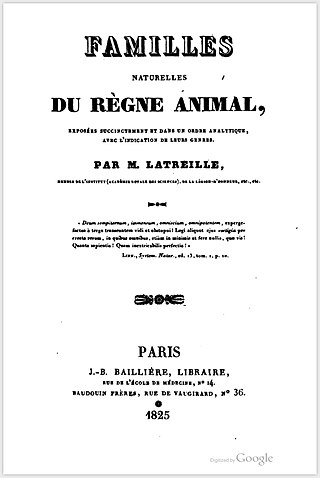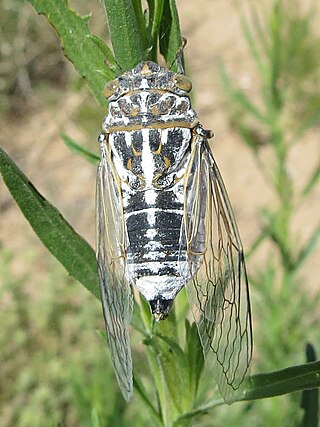
The cicadas are a superfamily, the Cicadoidea, of insects in the order Hemiptera. They are in the suborder Auchenorrhyncha, along with smaller jumping bugs such as leafhoppers and froghoppers. The superfamily is divided into two families, the Tettigarctidae, with two species in Australia, and the Cicadidae, with more than 3,000 species described from around the world; many species remain undescribed. Nearly all of cicada species are annual cicadas with the exception of the few North American periodical cicada species, genus Magicicada, which in a given region emerge en masse every 13 or 17 years.

The Cicadinae are a subfamily of cicadas, containing the translucent cicadas. They are robust cicadas and many have gaudy colors, but they generally lack the butterfly-like opaque wing markings found in many species of the related Tibiceninae.

Annual cicadas are Cicadidae species that appear every summer. The life cycle of an annual cicada typically spans 2 to 5 years; they are "annual" only in the sense that members of the species reappear once a year. The name is used to distinguish them from periodical cicada species, which occur only in Eastern North America, are developmentally synchronized, and appear in great swarms every 13 or 17 years. All other cicadas from other biogeographic regions produce annual broods, so the distinction is not made outside of North America.

Neotibicen tibicen, known generally as the swamp cicada or morning cicada, is a species of cicada in the family Cicadidae. It is widespread across much of the eastern and central United States and portions of southeastern Canada. There are two subspecies, N. tibicen tibicen and N. tibicen australis, with the latter replacing subspecies tibicen in portions of Florida, Georgia, and Alabama.

Tibicen is a former genus name in the insect family Cicadidae that was originally published by P. A. Latreille in 1825 and formally made available in a translation by A. A. Berthold in 1827. The name was placed on the Official Index of Rejected and Invalid Generic Names in Zoology by the International Commission on Zoological Nomenclature in 2021. Certain European cicada species that were included by some authors in this genus at the time of its suppression are now listed under genus Lyristes Horváth, 1926. Other formerly-Tibicen species are placed in the tribe Cryptotympanini and include the genera Auritibicen Lee, 2015, Hadoa Moulds, 2015 Megatibicen Sanborn and Heath, 2016, and Neotibicen Hill and Moulds, 2015.

The genus Hadoa comprises large-bodied Cicadidae occurring in Western North America. Until recently, these species were in the genus Tibicen, which has now been redefined so as to include only a few European species, while most species from the Eastern and Central US are now placed in Neotibicen and Megatibicen.
Neotibicen bermudianus, also colloquially known as the Bermuda cicada, is an extinct species of annual cicada that was endemic to the island of Bermuda.

Neotibicen robinsonianus, commonly called Robinson's cicada, is a species of large-bodied annual cicada in the genus Neotibicen. It is native to the Eastern United States.

Neotibicen linnei, commonly called Linne's cicada, is a species of large-bodied annual cicada in the genus Neotibicen. It is native to the Eastern United States and Canada. N. linnei in Oklahoma is most easily identified by the costal margin bent at the end of the radial cell and opercula truncated obliquely at the extremities.
Neotibicen latifasciatus, commonly called the coastal scissor grinder cicada, is a species of annual cicada in the genus Neotibicen.
Megatibicen figuratus, commonly called the fall southeastern dusk-singing cicada, is a species of annual cicada in the genus Megatibicen. Prior to its reclassification to the genus Megatibicen, M. figuratus was included in the genus Neotibicen.

Megatibicen resonans, commonly called resonant cicada or southern pine barrens cicada, is a species of annual cicada in the genus Megatibicen. Prior to its reclassification to the genus Megatibicen, M. resonans was included in the genus Neotibicen.

Megatibicen is a genus of cicadas in the family Cicadidae, with about 10 described species. Until 2016, these species were included in the genus Tibicen and then briefly in Neotibicen. The species formerly of genera Ameritibicen Lee, 2016 and Gigatibicen Lee, 2016 are now considered species of Megatibicen Sanborn & Heath, 2016.

Neotibicen davisi, known generally as the Davis' southeastern dog-day cicada or southern dog-day cicada, is a species of cicada in the family Cicadidae.

Neotibicen lyricen, the lyric cicada, is a species of cicada in the family Cicadidae.

Neotibicen winnemanna, commonly called the Eastern scissor(s) grinder, is a species of large bodied annual cicada in the genus Neotibicen. It is native to the Eastern United States, particularly the Piedmont Plateau and the outlying lower mountainous elevations of the Appalachians and inner, western portion of the Atlantic coastal plain.
Scissor grinder cicada may refer to:
Neotibicen similaris is a species of annual cicada in the genus Neotibicen. It is native to the Southeastern United States. Initially, N. similaris encompassed one distinct species of Neotibicen, though Marshall and Hill described in 2017 an apparent subspecies of N. similaris native to the Apalachicola region of Florida, Georgia, and Alabama. The initial species described now consists the N. similaris subspecies N. similaris similaris, while the newly described variant occupies the N. similaris apalachicola subspecies. They are similar, and the most reliable means of distinguishing the subspecies is the distinctive call of N. similaris apalachicola males; however, despite the distinctness of the mating calls, the two subspecies appear to hybridize in areas in which they overlap, resulting in songs that combine elements of both.
A scissor grinder is an antiquated term for a scissor or knife sharpener.

Lyristes is a genus of cicadas from Europe and the Middle East. It was described by G. Horvath in 1926.












